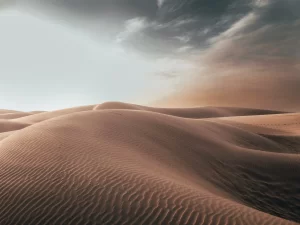Physical Address
23,24,25 & 26, 2nd Floor, Software Technology Park India, Opp: Garware Stadium,MIDC, Chikalthana, Aurangabad, Maharashtra – 431001 India
Physical Address
23,24,25 & 26, 2nd Floor, Software Technology Park India, Opp: Garware Stadium,MIDC, Chikalthana, Aurangabad, Maharashtra – 431001 India

By Vivek Saini
Rajasthan’s barren Thar desert may turn green, says a recent study. The study indicates that Climate Change could lead to such a transformation, though not immediately!
In the study published recently in the journal Earth’s Future, two researchers, PV Rajesh of the Indian Institute of Tropical Meteorology in Pune and BN Goswami of the Department of Physics at Cotton University in Guwahati, have proposed that the Thar desert may perish as a result of global warming.
How climate change patterns affect the Thar desert
Several studies have predicted the expansion of the world’s deserts due to global warming. For example, researchers project that the Sahara Desert will grow by nearly 6,000 square kilometres annually by 2050. The newly released study, on the other hand, provides an unusual perspective on the Thar Desert. According to the experts, the Thar Desert may buck this tendency and become green within the next century. The Thar Desert covers over 200,000 square kilometres of land. It is located partly in Rajasthan and Pakistan’s Punjab and Sindh provinces. Thar is the 20th largest desert in the world and the 9th largest hot subtropical desert globally.
It’s as eternal as the sunrise: Every year, the South Asian monsoon floods India’s green east while leaving the west, where India and Pakistan share a border bone-dry. The asymmetry between the Himalayan rainforests and the world’s most populous “Great Indian Desert” has formed civilisations. However, as climate change intensifies, the monsoon moves further west into this region.
“This is going to affect a billion people,” says Shang-Ping Xie, a Scripps Institution of Oceanography climate expert who was not involved in the research. He anticipates that the study’s findings will raise the likelihood of floods in the Great Indian Desert, commonly known as the Thar Desert, similar to what happened in 2022 in Pakistan when a deluge displaced 8 million people and inflicted almost $15 billion in property damage.
Why is Thar desert defying the trend of Desertification?
The study suggests that the Indian monsoon’s eastward movement has had a critical role in contributing to the arid conditions in India’s west and northwest. These regions historically supported The Indus Valley civilisations, thriving throughout the monsoon season. According to the researchers, reversing this trend and causing the current Indian monsoon to move further west might drastically alter India’s west and northwest areas by bringing about humid “monsoonal” conditions. This shift may improve food security for the growing population of the country.
The study’s lead author, B. N. Goswami of Cotton University in Guwahati’s Department of Physics, claims that comprehension of the dynamics of the Indian summer monsoon is essential to understanding how the climate may green the Thar Desert. “This happens due to the seasonal migration of the rainband or the active Inter-Tropical Convergence Zone (ITCZ) from south of the equator over the Indian Ocean in winter to about 25 degrees North in summer over the Indian continent,” Goswami added.
What factors are responsible
In developing their proposal, Rajesh and Goswami focused on the so-called “Indian Ocean warm pool,” or IOWP, for which they relied on rainfall and climate data. It has been known for decades that there is a warm area in the Indian Ocean that produces monsoons. Due to climate change, the IOWP is currently growing westward.
The IOWP is quite fascinating in itself. Why might one area of a large, open ocean, at roughly the same latitudes, be warmer? Goswami admitted that “the sun does try to warm everywhere.” Although air winds cause the ocean surface to evaporate, they also occasionally cause colder, deep waters to rise, a process known as “upwelling.” In the western Arabian Sea during the summer, this occurs close to the Somalian coast. Since the local waters are cooler, there isn’t a “warm pool” there. Evaporating water then rises near the warm pool’s western margin. The earth’s rotation pulls them diagonally over India.
As a result, the northeastern region receives rainfall for 150 days. In contrast, according to Rajesh and Goswami, the north-western area receives rainfall for only 70 days. The IOWP’s westward expansion would result in “a 50-100 per cent increase in the mean summer rainfall over the semi-arid northwest of India,” according to their study. Scientists believe the Thar desert might receive adequate rainfall and evolve into a green region.
Scientist’s prediction about when this will happen
It is impossible to predict if it will occur in 50 or 100 years. Still, Goswami said that the Indian monsoon will continue to move west as long as global warming, which is expected to last until the end of the century, goes on. By then, it is anticipated that the monsoon season will last an additional 70 to 90 days, and the yearly rainfall will increase from 45 to 70 cm. Taller vegetation will grow due to the higher rain dispersed over a more extended season.
However, if water isn’t made available to the plants during the dry winter months through irrigation or water table elevation, they could perish. Therefore, if the run-off during the monsoon season could be harvested, greening would be enhanced. The increasing rainfall can green the desert and considerably raise food production in the long run. According to Goswami, however, it is imperative to make plans for collecting the extra water in the short term to boost groundwater reserves.
References: